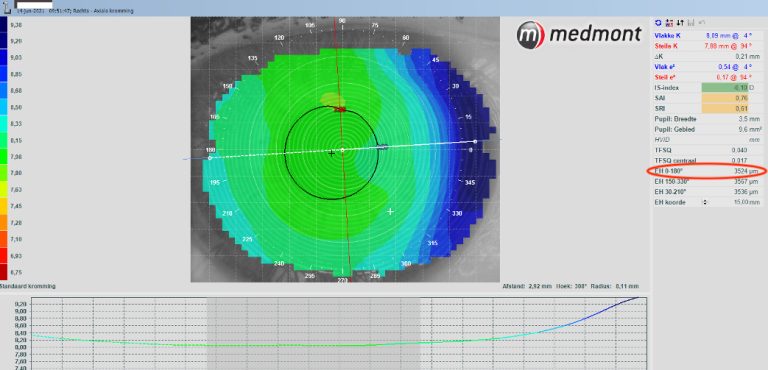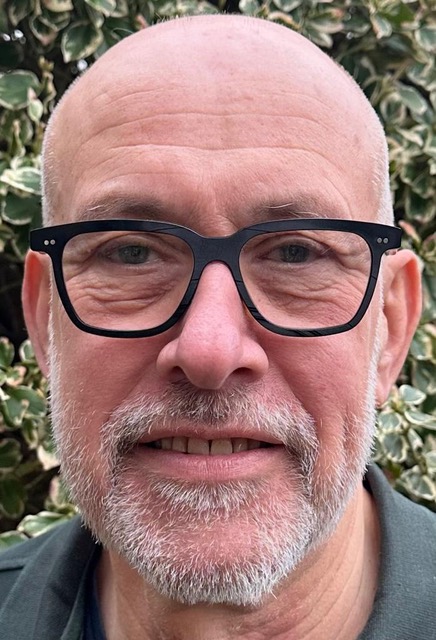Using a Customized Soft Lens
Sometimes ‘flat out’ the best option for a flat eye
By Gerard Smits
Introduction
The vast majority of the lenses we fit in contact lens practice are soft lenses. The amount of attention that goes into ‘fitting’ soft lenses is limited in contrast to the focus on scleral lens fitting, corneal lens fitting, and orthokeratology, for instance. This case shows how taking control of the fitting process can sometimes enhance someone’s life and upgrade one’s vision in relation to quality of life.
Subjective
Mary came to our practice right in the heart of Amsterdam in the Netherlands. Her wish was to wear lenses in addition to the glasses that she used, with a preference for daily disposables if possible. The anamneses did not reveal any specific considerations or limitations for fitting with a soft lens. Patient complains of moderate dry eye symptoms.
Objective
General slit lamp examination revealed no abnormalities. We focus on the right eye of the patient for this case report. Refraction of the right eye came down to S+2.75, with a corneal diameter (white-to-white with the Medmont topographer) of 12.0mm with an overall average eccentricity of over four quadrants of 0.43.
In our contact lens practice, emphasis is on the shape of the entire anterior ocular surface, not just the central cornea. We use a Medmont corneal topographer for this reason, but with a special tool: the E-H software¹.
Based on the overall corneal topography using that instrument, combined with the peripheral corneal angle measured with the topographer and using the sagittal height calculator – the overall sagittal height of the ocular surface (OC-SAG) over 15mm can be estimated, typically the horizontal meridian values are used.
In this case, the E-H 0-180° value 3524 microns. This figure is well below the OC-SAG of the average eye, which is estimated to be in the 3750 micron range. This eye also falls outside the one-standard deviation range (1-SD), which is between 3550-3950 microns.

Assessment
The fact that this eye falls outside (on the left side) of the normal distribution bell-curve and even outside the 1-SD range – indicates that this is an exceptionally flat eye. Based on keratometry values alone (8.09/7.88) it is not easy to make the same judgement, especially as the eye has an average e-value and standard corneal diameter. In cases like this, measuring the full ocular surface over at least the diameter of the soft lens (or the benchmark 15mm is used as a standard often) can be very insightful.
For this patient, several standard soft lenses were tried, including Dailies Aqua Comfort Plus (Alcon) BC 8.70 Ø 14.0, Clariti 1 Day (CooperVision) BC 8.60 Ø 14.1, Dailies All Day Comfort BC 8.60 Ø 13.80 and monthly disposable Biofinity (Alcon) BC8.60 Ø 14.0 and Fresh Excellent (Microlens/Wölk) BC 8.3 Ø 13.6. All lenses failed because of lack of movement and mobility, in addition to poor comfort.
Plan
Patient ultimately was refitted with a custom soft lens based on the patient’s corneal topography. The Medmont file was uploaded to the manufacturer and an individual monthly disposable silicone hydrogel lens was created for this patient. The Indivisual (Menicon, Emmen NL) was manufactured in the Definitive 74 material (Efrofilcon A V3) with a sagittal height of the lens (CL-SAG) of 2900 micron and a tangential peripheral shape (tangent angle 54°) S+2.50 in a Ø 14.1.
The lens design is similar to how many scleral lens designs are configured these days. The lens fit procedure would also be close to fitting a scleral lens: changing the tangent angle would ‘lift’ the lens, decreasing the lens to a lower sagittal height. For this patient, this lens design resulted in an optimal lens fit with excellent movement – which is believed to be the result of the tangential peripheral shape of the lens in conjunction with the customized CL-SAG height.
In Summary
Using the overall sagittal height of the ocular surface over a 15mm chord can give the eye care practitioner (ECP) valuable information about when to start with a flat or steep lens (a low or high CL-SAG) using the Pacific University SAG-charts, or when to divert to an out-of standard or a customized lens – like in this case. This will save time, on behalf of the patient and the ECP, from fewer trial lenses used and increased overall satisfaction. Consequently, this can potentially prevent drop-out of soft lens wear.
The initial lens type requested by the patient, daily disposables, come in a variety of brands but are limited in size and parameters. It is the task of the ECP to assess and decide which lens is suitable for a given eye and which is not. This case perfectly illustrates the decision-making process, and a custom-made lens in a silicone hydrogel material with a monthly replacement schedule is the ideal solution for the patient. The patient still desires a daily disposable lens, if possible, but that is not feasible in this case. As ECPs we must be clear about this. In regard to the patient’s complaint of moderate dry eye symptoms – as ECPs we must be careful with that. Any form and type of eye discomfort can be easily mistaken for dry eye. But often, lens fit problems are partially or fully the root cause of discomfort issues, and lens fit issues need to be addressed first. The ‘take-home message’ in this case was pretty obvious: a flat lens for this flat eye was the best technical option for this patient.
¹the E-H tool in the Medmont topographer can be added simply, using the manufacturer’s guidelines.
This case study is part of a series focusing on speciality soft lens fitting. Stay tuned for the next installment coming soon. Special thanks to Eef van der Worp for bringing this series together.

Gerard comes from a long line of opticians (grandparents, father and brother are all opticians). He graduated from the Christiaan Huygenschool (optics) in Rotterdam, and started working as a contact lens specialist in 1985. Since then he has been a member of the ANVC (Dutch Contact Lens Association). He has specialized in both rigid and soft lens fitting and has worked as a consultant for many industry partners, and tested different (specialty) lenses in his practice for the industry. He works as Ralph Optiek in the center of Amsterdam. His experience includes specialty lenses, such as orthokeratology, rigid corneal lenses after refractive surgery and fitting of custom soft lenses. Customization of lens fiting using corneal topography data and multifocal (rigid corneal and soft) lens fitting are two of the main challenges, but also opportunities he sees for your profession.
